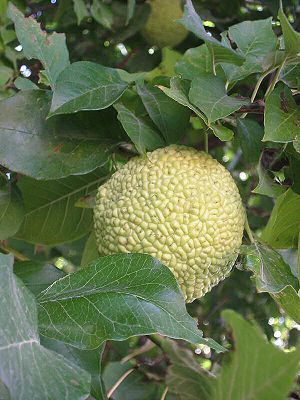Difference between revisions of "Maclura pomifera"
Jump to navigation
Jump to search
m (1 revision: Maclura pomifera) |
(cut down) |
||
| Line 1: | Line 1: | ||
| − | |||
| − | |||
{{speciesbox | {{speciesbox | ||
|name = Osage Orange | |name = Osage Orange | ||
| Line 17: | Line 15: | ||
|synonyms_ref = <ref>{{cite web|url=http://www.tropicos.org/name/21300468 |title=Tropicos |publisher=Tropicos |date= |accessdate=2014-02-24}}</ref><ref>{{cite web|url=http://www.theplantlist.org/tpl1.1/record/kew-2501306 |title=The Plant List |publisher=The Plant List |date= |accessdate=2014-02-24}}</ref> | |synonyms_ref = <ref>{{cite web|url=http://www.tropicos.org/name/21300468 |title=Tropicos |publisher=Tropicos |date= |accessdate=2014-02-24}}</ref><ref>{{cite web|url=http://www.theplantlist.org/tpl1.1/record/kew-2501306 |title=The Plant List |publisher=The Plant List |date= |accessdate=2014-02-24}}</ref> | ||
}} | }} | ||
| − | |||
| − | |||
| − | |||
| − | |||
| − | |||
| − | |||
| − | |||
| − | |||
| − | |||
| − | |||
| − | |||
| − | |||
| − | |||
| − | |||
| − | |||
| − | |||
| − | |||
| − | |||
| − | |||
| − | |||
| − | |||
| − | |||
| − | |||
| − | |||
| − | |||
| − | |||
| − | |||
| − | |||
| − | |||
| − | |||
| − | |||
| − | |||
| − | |||
| − | |||
| − | |||
| − | |||
| − | |||
| − | |||
| − | |||
| − | |||
| − | |||
| − | |||
| − | |||
| − | |||
| − | |||
| − | |||
| − | |||
| − | |||
| − | |||
| − | |||
| − | |||
| − | |||
| − | |||
| − | |||
| − | |||
| − | |||
| − | |||
| − | |||
| − | |||
| − | |||
| − | |||
| − | |||
| − | |||
| − | |||
| − | |||
| − | |||
| − | |||
| − | |||
| − | |||
| − | |||
| − | |||
== References == | == References == | ||
{{Reflist|30em}} | {{Reflist|30em}} | ||
| − | + | {{Ack-Wikipedia}} | |
| − | {{ | ||
| − | |||
| − | |||
| − | |||
| − | [[Category: | + | [[Category:Moraceae]] |
| − | + | [[Category:Plants for Keenan to eat]] | |
| − | |||
| − | |||
| − | |||
| − | |||
| − | |||
| − | [[Category:Plants | ||
| − | |||
Latest revision as of 11:15, 23 November 2018
| Osage Orange | |
|---|---|

| |
| Foliage and multiple fruit | |
| Scientific classification | |
| Kingdom: | Plantae |
| Clade: | Angiosperms |
| Clade: | Eudicots |
| Clade: | Rosids |
| Order: | Rosales |
| Family: | Moraceae |
| Genus: | Maclura |
| Species: | M. pomifera
|
| Binomial name | |
| Maclura pomifera (Raf.) Schneid.
| |
| Synonyms[1][2] | |
| |
References
- ↑ "Tropicos". Tropicos. Retrieved 2014-02-24.
- ↑ "The Plant List". The Plant List. Retrieved 2014-02-24.
Acknowledgements
This article uses material from the Wikipedia article Maclura pomifera, which is released under the Creative Commons Attribution-Share-Alike License 3.0.